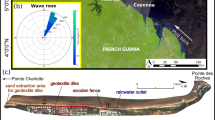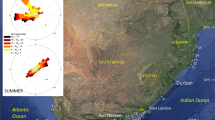Abstract
The morphology of many Spanish estuarine mouths has been modified over recent decades to improve access to the harbours located inside. The normal practice has been the construction of jetties along one or both sides of the mouth to improve the flow though the main estuarine channel and thereby prevent the formation of bars in the main channel bed and ebb-tidal delta lobes or mouth bars in the mouths. The new wave refraction/diffraction dynamics created by these structures induces a strong modification of the beach–dune systems. In the zones adjacent to the jetties, a rapid migration occurs until the beach profile and the associated dune field stabilise, which occurs when the confined space is unable to retain more sediment. This process may include the reworking of outer sandy bottoms and the generation of new stabilised bars. A portion of the sand used by waves to form this accretion is supplied by erosive processes occurring during the same period on the beaches and dune fronts located in areas further away from the jetties, which in many cases are heavily used. The aim of this paper was to analyse the accretion geometries and rates of beach–dune systems in several estuaries that drain into the Cantabrian coast and the subsequent erosion in the outer dune belt, testing a conceptual model formulated to explain the factors that determine the beach–dune response to human actions. The methodology applied can be exportable to other regions to facilitate the prediction of anthropic effects from harbour development and coastal management policies and the subsequent conservation of these environments.






Similar content being viewed by others
References
Alonso A, Pagés JL (2010) Evolución del nivel del mar durante el Holoceno en el noroeste de la Península Ibérica. Rev Soc Geol Esp 23:157–167
Baptista P, Bernardes C (2009) Terrazas del río Miera. A highly energetic beach in the dependance on coastal defence structures (Northwest of Portugal). Proc. VI Simposio sobre el Margen Ibérico Atlántico. In: Flor G, Gallastegui J, Flor-Blanco G, Martín J (eds). Univ. de Oviedo, pp 169–172
Beltrán R, de la Rosa JD, Santos JC, Beltrán M, Gomez-Ariza JL (2010) Heavy metal mobility assessment in sediments from the Odiel River (Iberian Pyritic Belt) using sequential extraction. Environ Earth Sci 61(7):1493–1503
Bonachea J, Bruschi VM, Hurtado M, Forte LM, da Silva M, Etcheverry R, Cavallotto JL, Dantas M, Pejon O, Zuquette L, Bezerra MA, Remondo J, Rivas V, Gómez-Arozamena J, Fernández G, Cendrero A (2010) Natural and human forcing in recent geomorphic change; case studies in the Rio de la Plata basin. Sci Total Environ 408:2674–2695
Bruschi VM, Bonachea J, Remondo J, Gómez-Arozamena J, Rivas V, Méndez G, Naredo JM, Cendrero A (2013) Analysis of geomorphic systems response to natural and human drivers in northern Spain: implications of global geomorphic change. Geomorphology 196:267–279
Carriquiry JD, Villaescusa JA, Camacho-Ibar V, Daesslé LW, Castro-Castro PG (2011) The effects of damming on the materials flux in the Colorado River delta. Environ Earth Sci 62(7):1407–1418
CERC (Shore Protection Manual) (1984) U.S. Army Corps of Engineering Research Center. Government Printing Office, Washington DC
Chust G, Borja A, Liria P, Galparsoro I, Marcos M, Caballero A, Castro R (2009) Human impacts overwhelm the effects of sea-level rise on Basque coastal habitats (N Spain) between 1954 and 2004. Estuar Coast Shelf Sci 84:453–462
Dalrymple RW, Zaitlin BA, Boyd R (1992) Estuarine facies models: conceptual basis and stratigraphic implications. J Sediment Petrol 62:1130–1146
Díez JJ (2001) Rías cantábricas con puertos y puertos en rías. Rev Obras Públicas 3406:45–56
Duck RW, McManus J, Díez J (1995) Comparative study of two largely infilled estuaries: the Eden Estuary (Scotland) and the Ria de Foz (Spain). Neth J Aquat Ecol 29:203–210
El-Asmar HM, White K (2002) Changes in coastal sediment transport processes due to construction of New Damietta Harbour, Nile Delta, Egypt. Coast Eng 46:127–138
Fernandes S, Pillay S (2012) A study of the net flux of nitrates from estuaries of the eThekwini Municipality of Durban, KwaZulu-Natal South Africa. Environ Earth Sci 67(8):2193–2203
Fernández-Valdés JM (1997) Morfología y Sedimentación de la Plataforma Continental Interna del Área Central de Asturias. Ph.D. Thesis (unpublished). Escuela Superior de la Marina Civil. Universidad de Oviedo
Flemming BW, Delafontaine MT, Liebezeit G (eds) (2000) Muddy coast dynamics and resource management. Proceedings in Marine Science, 2. Elsevier, Amsterdam
Flor G (1980) Las dunas costeras de Cantabria: valores singulares geológicos. Proc. I Reunión de Geología Ambiental y Ordenación del Territorio, Santander, p 22
Flor G (1992) Tipología, catalogación y tendencias de los procesos de erosión/sedimentación en los campos dunares de la costa de Galicia (NO de España). Thalassas 10:9–39
Flor G, Flor-Blanco G (2005) An introduction to the erosion and sedimentation problems in the coastal regions of Asturias and Cantabria (NW Spain) and its implications on environmental management. J Coast Res SI 49:58–63
Flor G, Flor-Blanco G (2014) Raised beaches in the Cantabrian coast. In: Gutiérrez F, Gutiérrez M (eds) Landscapes and Landforms of Spain, World Geomorphological Landscapes, Springer, Spain. DOI: 10.1007/978-94-017-8628-7_20
Flor G, Peón A (2004) Rasas y superficies de erosión continental en el relieve alpídico del noroeste peninsular y los depósitos terciarios. In: Araújo MA, Gomes A (eds) Geomorfología do NW da Península Ibérica. Univ. Porto, pp 13–31
Flor-Blanco G, Flor G (2009) Aspectos geomorfológicos del tramo inferior del estuario de Villaviciosa (Asturias) en relación con su evolución histórica. Rev Soc Geol Esp 22:123–136
Flor-Blanco G, Flor G (2012) Clasificación geomorfológica y características de los estuarios cantábricos (NW de España). In: PubliCan (eds) Avances de la Geomorfología en España 2010–2012, Santander, pp 315–318
Flor-Blanco G, Flor G, Pando L (2013) Evolution of the Salinas-El Espartal and Xagó beach/dune systems in north-western Spain over recent decades: evidence for responses to natural processes and anthropogenic interventions. Geo Mar Lett 33:143–157
Frihy O, Deabes E (2012) Erosion chain reaction at El Alamein Resorts on the western Mediterranean coast of Egypt. Coast Eng 69:12–18
GIOC (1998) Cota de inundación: Atlas de inundación costera del litoral español. Documento temático. Grupo de Ingeniería Oceanográfica y de Costas. Universidad de Cantabria. Ministerio de Medio Ambiente (Dirección General de Costas), p 59
Gómez-Pina G, Muñoz-Pérez JJ, Ramírez JL, Carlos L (2002) Sand dune management problems and techniques, Spain. J Coast Res 36:325–332
González M, Uriarte A, Fontán A, Mader J, Gyssels P (2004) Marine Dynamics. In: Borja A, Collins M (eds). Oceanography and Marine Environment of the Basque Country. Elsevier Oceanographic Series 70, pp 133–157
González M, Uriarte A, Pozo R, Collins M (2006) The Prestige crisis: operational oceanography applied to oil recovery by the Basque fishing fleet. Mar Pollut Bull 53:369–374
Halouani N, Fathallah S, Gueddarei M (2012) Beach and nearshore morphodynamic changes of the Tabarkacoast, Northwest of Tunisia. Environ Earth Sci 66:1059–1069
Hardaway CS, Varnell LM, Milligan DA, Thomas GR, Hobbs CH (2001) Chesapeake Bay Dune Systems: Evolution and Status. Final report to the Virginia Department of Environmental Quality, p 74
Haupt LM (1888) Jetties for improving estuaries. J Franklin Inst 125:306–313
Haupt LM (1905) A menace to the New York harbor entrance. J Franklin Inst 159:101–116
Hsu JRC, Silvester R (1990) Accretion behind single offshore breakwater. J Waterway Port Coast Ocean Eng 116:362–380
Hsu JRC, Uda T, Silvester R (1993) Beaches downcoast of harbours in bays. Coast Eng 19:163–181
Inman DL, Brush B (1973) The coastal challenge fragile ribbons which border our land require more understanding new technology and resolute planning. Science 181:20–31
Iskander M, Frihy O, El Ansary A, Abd El Mooty M, Nagy H (2007) Beach impacts of shore-parallel breakwaters backing offshore submerged ridges, Western Mediterranean Coast of Egypt. J Environ Manag 85(4):1109–1119
Kieslich JM (1981) Tidal inlet response to jetty construction. Department of Army. Corp of Engineers. GITI report 19. Virginia, p 64
Komar PD (1983) Coastal erosion in response to the construction of jetties and breakwaters. In: Komar PD (ed) CRC Handbook of Coastal Processes and Erosion. CRC Press, Boca Raton, pp 191–204
Koutsikopoulos C, Le Cann B (1996) Physical processes and hydrological structures related to the Bay of Biscay anchovy. Sci Mar 60:9–19
Leorri E, Cearreta A (2009) Recent sea-level changes in the southern Bay of Biscay: transfer function reconstructions from saltmarshes compared with instrumental data. Sci Mar 73:287–296
Leorri E, Cearreta A, Milne G (2012) Field observations and modelling of Holocene sea-level changes in the southern Bay of Biscay: implication for understanding current rates of relative sea-level change and vertical land motion along the Atlantic coast of SW Europe. Quat Sci Rev 42:59–73
López Peláez J, Flor G (2006) Cambios morfológicos por canalización de la desembocadura en los estuarios asturianos de Navia, Nalón y Villaviciosa. In: Pérez Alberti A, López Bedoya J (eds) Proceedings IX Reunión Nacional de Geomorfología. Pub. Univ. Santiago de Compostela. pp 419–431
Lorenzo F, Alonso A, Pagés JL (2007) Erosion and accretion of beach and spit systems in Northwest Spain: a response to human activity. J Coast Res 23:834–845
Mahiques MM, Figueira RCL, Salaroli AB, Alves DPV, Gonçalves C (2013) 150 years of anthropogenic metal input in a biosphere reserve: the case study of the Cananéia-Iguape coastal system, southeastern Brazil. Environ Earth Sci 68(4):1073–1087
McFadden L, Nicholls RJ, Penning-Rowsell EC (eds) (2007) Managing coastal vulnerability. Elsevier, Amsterdam
Méjica J, Méndez B (eds) (2004) Puerto de San Esteban de Pravia. Ilustración de cien años de tráficos. Fundación Méjica, Oviedo
Morales JA, Borrego J, Ballesta M (2004) Influence of harbour constructions on morphosedimentary changes in the Tinto-Odiel estuary mouth (South-West Spain). Environ Geol 46:151–164
Moutzouris CI (1990) Effect of harbour works on the morphology of three Greek coasts. In: Proc. 27th Int. Nav. Congress, pp 17–21
Noble RM (1978) Coastal structure effect on shorelines. In: Proc. 16th Coastal Engineering., Conf., ASCE, Hamburg, pp 2069–2085
Pietrafesa LJ (2012) On the continued cost of upkeep related to groins and jetties. J Coast Res 28(5):3–9
Ramillien G, Bouhours S, Lombard A, Cazenave A, Flechtner F, Schmidt R (2008) Land water storage contribution to sea level from GRACE geoid data over 2003–2006. Glob Planet Change 60:381–392
Rivero Cueto S, Blanco Sarasola M, Balbín Loredo I (1995) Villaviciosa en fotos antiguas (1859–1936). In: La Oliva (ed) Papeles Maliayos 3. Villaviciosa
Rodríguez-Ramírez A, Morales JA, Delgado I, Cantano M (2008) The impact of man on the morphodynamics of the Huelva coast (SW Spain). J Iber Geol 34:313–327
Roig-Munar FX (2007) Microerosión inducida por los usuarios de las playas. El caso de Menorca (Islas Baleares). Investig Geogr 43:161–167
Savage RP (1959) Laboratory study of the effect of groins in the rate of littoral transport. Army Corps of Engineers, Beach Erosion Board, Technical Memo, U.S, p 114
Seymour RJ, King DB (1982) Field comparisons of cross-shore transport models. J Waterway Port Coast Ocean Eng 108:163–179
Spataru AN (1990) Breakwaters for the protection of Romanian beaches. Coast Eng 14:129–146
Tamura T (2012) Beach ridges and prograded beach deposits as palaeoenvironment records. Earth Sci Rev 114:279–297
Tresca A, Ruz M-H, Raison S, Grégoire P (2012) Management of aeolian sand transport on a dike, Dunkirk Seaport, France. Proc. 33rd Int. Conference on Coastal Engineering ICCE 2012, Santander, Spain, 1-6 July 2012
Uda T, Noguchi K (1991) Beach changes around lwafune port in northern Niigata Prefecture. Tech Notes Civ Eng Jpn 33:28–33
Vollmer M, Grann H (eds) (1999) Large-scale constructions in coastal environments. Conflict resolution strategies. Springer, Berlin
Acknowledgments
We are grateful to the port authorities and cartographic services of Galicia, Asturias, Cantabria and Basque Country for providing data on the case studies presented. We also thank the Asturias Emergency Service for information about Rodiles beach users. Comments from American Journal editors and scientific reviewers have been very helpful for improving the original manuscript. We gratefully acknowledge their assistance.
Author information
Authors and Affiliations
Corresponding author
Rights and permissions
About this article
Cite this article
Flor-Blanco, G., Pando, L., Morales, J.A. et al. Evolution of beach–dune fields systems following the construction of jetties in estuarine mouths (Cantabrian coast, NW Spain). Environ Earth Sci 73, 1317–1330 (2015). https://doi.org/10.1007/s12665-014-3485-1
Received:
Accepted:
Published:
Issue Date:
DOI: https://doi.org/10.1007/s12665-014-3485-1




